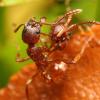First hot day, 80+ degrees, they will fly. Look at night on fallen logs and such where they nest. As for keeping them, they are really quite hardy. My queen lost all her workers due to my rookie mistakes, but now has larvae that she has been tending to. This species loves heat, and they will not do well without it. They are quite genetically similar, almost identical to C. Pennsylvanicus, so care is the same. They can grow fast according to Nurbs, 30+ workers in the first year is definitely possible if you provide heat up to ~85 degrees Fahrenheit.
As for the mesh, 300 micron stainless steel will not rust and is strong. There is an alternative that I know of, but it's a lot more expensive, called polypropylene mesh. They both work fine though. If you want to use fiberglass, go for it, I'm just not so sure how well it will hold up.
Colorado's weather is really erratic - we've already had a handful of 80f+ days over the past couple of months, with snow and freezing temperatures in between. I would say yesterday was the first really hot day of spring, and we had some decent rain last night. Today is 55f+ with humidity around 60%. We'll have more rain later this week, and then hot temperatures (70f+) on Friday and Saturday.
Without someone local guiding me, I'm having a hard time figuring out what to expect from my local ant populations. 
I wasn't exactly regarding the size of the tank; I was mostly referring to the corners and problems of tanks in general. Rounded corners make things significantly easier.
I have a drainage layer with activated charcoal as well. I laid down a layer of larger sized rocks that the ants couldn't easily pick up and move. Makes the tank heavier but you'll be fine with a smaller tank.
To be honest, if the drainage layer actually ever gets used, it's likely way to much water. I'd try and side with having a substrate that doesn't dry out as much on top. I used cactus substrate for the layer closest to the drainage layer and the rest a mixture of substrates and a little clay to help with a digging medium just in case.
Gotcha. The container I have does have corners, but they aren't like the caulked corners of a fishtank. It's solid glass. I think that fluon applied to the sloped part at the top will do just fine keeping them contained. I don't really care if they climb on the walls inside the container itself.
So, did you essentially lay down a charcoal layer, and then put down large pea gravel or something similar that the ants can't move or get through? My nightmare would be seeing my drainage layer full of dead ants that somehow got down there and couldn't get out! I agree that if there is standing water in the drainage layer, it would be an indicator that the container is too wet for the ants. Even with a very compact rocky layer, I'd still feel inclined to lay down some layer(s) of meshing, just for good measure...
I was planning on just using sterilized (baked) native soil from my back yard as a substrate, possibly with some pine mulch mixed in. Colorado's soil is primarily clay that expands and clumps up when it's wet, but totally disintegrates when it's dried out. Our native soil is always a little bit moist 2-3 inches below the surface, even though we don't get much precipitation.




















